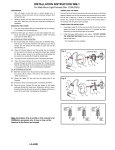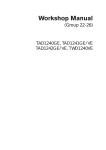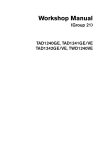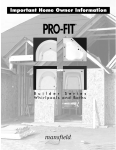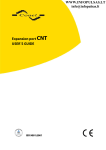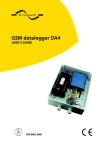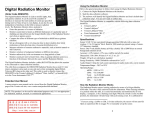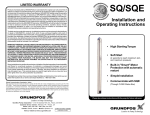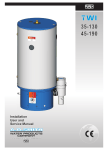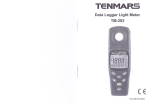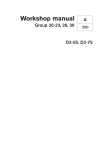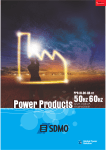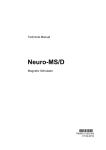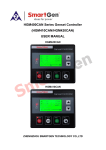Download 1241 WS2
Transcript
Workshop Manual Technical Data TAD1240GE, TAD1241GE/VE TAD1242GE/VE, TWD1240VE Technical data Engine TAD1240GE, TAD1241GE/VE TAD1242GE/VE, TWD1240VE Contents Safety information ................................................ 2 Introduction ......................................................... 2 Important ............................................................ 2 General information ............................................. 5 About the Service Manual ................................... 5 Spare parts ......................................................... 5 Certificated engines ............................................ 5 Technical data ...................................................... 6 References to Service Bulletins .......................... 31 Group 20 Safety information The Service Manual contains technical data, descriptions and repair instructions relating to the Volvo Penta products or product versions included in the list of contents. Make sure you use the right workshop literature. Read the safety information, “General information” and “Repair instructions” carefully before starting any service work. If work is carried out near an engine that is running, an incautious movement or a dropped tool could in the worst case lead to bodily harm. Be mindful of hot surfaces (exhaust pipes, the turbocharger, charge air pipes, starter elements, etc.) and hot liquids in lines and hoses on an engine that is running or has just been stopped. Before starting the engine, refit all guards and protective elements that were removed in the course of carrying out service work. Important The following special warning symbols occur in the Service Manual and on the product. WARNING! Warns of the risk of injury and extensive damage to the product or property, or that serious functional faults could arise if the instructions are not followed. IMPORTANT! Used to draw attention to anything that could cause damage to the product or property or functional disorders in the same. NOTE: Used to draw attention to important information for facilitating work operations or handling. To provide an overview of the risks you should always be aware of and the precautionary measures that should always be adopted, we have listed them here. Make it impossible for the engine to start. Turn off the current by means of the main switch (or switches) and lock it (them) in the OFF position before starting service work. Affix a warning sign in the driver’s area. As a rule, all service work should be carried out when the engine is stationary. Some work, including certain adjustments, nonetheless requires the engine to be running. Approaching an engine that is running could be dangerous. Bear in mind that loose-fitting clothes or long hair may get caught in rotating parts and cause serious injury. Make sure that the warning and/or information decals affixed to the product are always in plain sight. Replace decals that are damaged or have been painted over. Never start the engine unless the air filter is fitted. The rotating impeller in the turbo could cause serious injuries. Foreign objects in the inlet line could additionally cause machinery damage. Never use a starter spray or the like to help start the engine. It could cause an explosion in the inlet manifold. Danger of injury. Start the engine in well-ventilated premises only. If the engine is run in a confined space, exhaust gases and crankcase gases should be conducted away from the engine bay or workshop area. Avoid opening the coolant filler cap when the engine is still hot. Steam or hot coolant could squirt out while the built-up pressure will be lost. If necessary, open the filler cap slowly and release the pressure in the cooling system. Be extremely careful if a cock, plug or coolant line has to be removed while the engine is still hot. Steam or hot coolant could squirt out in an unexpected direction. Group 20 Hot oil can cause burns, Avoid getting hot oil on your skin. Make sure that the lubricating system is depressurized before starting any work on it. Never start or run the engine with the oil filler cap removed as oil under pressure could then escape. Stop the engine before doing any work on the cooling system. Always use protective goggles when carrying out work where splinters, grinding sparks and splashes of acid or other chemicals could occur. The eyes are especially sensitive and an injury could result in loss of sight. Avoid getting oil on your skin. Prolonged or recurring contact with oil can remove the skin’s natural moisture with irritation, dehydration, eczema and other skin disorders as a result. From a hygienic point of view, used oil is more harmful than fresh oil. Wear protective gloves and avoid clothes and rags ingrained with oil. Wash yourself regularly, particularly before mealtimes. Use skin lotion intended for this purpose to avoid dehydration and to facilitate cleansing of the skin. Most chemicals intended for the product (such as engine and transmission oils, glycol, petrol and diesel oil) or chemicals for workshop use (such as degreasants, paints and solvents) are injurious to the health. Carefully read the instructions on the package. Always follow the prescribed safety rules (such as the use of respirators, protective goggles, gloves, etc.). Make sure that other personnel are not exposed without their knowledge to substances that are injurous to health, such as through the air they breathe. Make provision for good ventilation. Deal with used and surplus chemicals in the prescribed manner. Exercise great care when detecting leaks in the fuel system and testing fuel nozzles. Wear protective goggles. The jets from a fuel nozzle are under very high pressure and have great penetrative power; the fuel can penetrate deep into body tissues and cause serious injury. Risk of blood poisoning. General instructions WARNING! Under no circumstances should the engine’s pressure pipes be bent or reshaped. Damaged pipes must be changed. All fuels and many chemicals are flammable. Make sure that they cannot be ignited by a naked flame or spark. Petrol, certain diluents and hydrogen from batteries, when mixed with air in the right proportions, are highly flammable and explosive. No smoking! Arrange for adequate ventilation and take the necessary safety measures prior to the start of welding or grinding work in the vicinity. Always keep a fire extinguisher easily accessible at the workplace. Ensure that rags saturated with oil and fuel, as well as used fuel and oil filters, are kept in a safe place prior to their disposal. Under certain conditions, spontaneous combustion can occur in oil-ingrained rags. Used fuel and oil filters comprise environmentally hazardous waste and, together with used lubricating oil, contaminated fuel, residual paint, solvents, degreasants and residual detergents, should be taken to a suitable plant for destruction. Batteries should never be exposed to naked flames or electric sparks. Never smoke near the batteries. When the batteries are being charged they give off hydrogen which, when mixed with air, forms oxyhydrogen gas. This gas is highly flammable and extremely explosive. A spark, which can occur if the batteries are connected incorrectly, could cause a battery to explode with injury and damage as a result. Do not disturb the connections when attempting to start (risk of sparks) and do not lean over any of the batteries. Never mistake the positive and negative terminals for each other when installing the batteries. If this happens it could cause serious damage to the electrical equipment. Compare with the wiring diagram. General instructions Always wear protective goggles when charging and handling batteries. The battery electrolyte contains highly corrosive sulphuric acid. If it gets on your skin, wash the affected area with soap and plenty of water. If the electrolyte gets in your eyes, rinse them at once with plenty of water and see a doctor as soon as possible. Stop the engine and cut off the current with the main switch (or switches) before starting to work on the electrical system. The clutch should be adjusted with the engine switched off. Use the lifting eyes mounted on the engine when lifting it. Always check that all lifting equipment is in good condition and that it has the right capacity for the job (engine weight plus reversing gear and extra equipment, if any). To ensure safe handling and to avoid damaging components mounted on the top of the engine, it should be lifted using an adjustable lifting beam or one suitably adapted to the engine. All chains or cables should run parallel to each other and as perpendicular as possible to the top of the engine. If other equipment that has been connected to the engine changes its centre of gravity, special lifting devices may be needed to obtain the right balance and ensure safe handling. Never carry out any work on an engine that is suspended solely from a lifting device (hoist, etc.). 4 Group 20 Never work alone when heavy components are to be removed, not even when a safe lifting device like a lockable block and tackle is used. Even when a lifting device is used two people will generally be required, one to handle the lifting device and the other to make sure that the components go clear and are not damaged when lifted away. Always make sure in advance that there is sufficient space for dismantling to be carried out in the area with no danger of it causing injury or material damage. WARNING! Electrical system and fuel system components on Volvo Penta products are designed and manufactured to minimize the risk of explosion and fire. The engine must not be run in environments where they will be surrounded by explosive media. Always use fuel recommended by Volvo Penta. See the Owner’s Manual. The use of a poorer grade of fuel could damage the engine. On a diesel engine, a poor grade of fuel could lead to binding of the control rod and overrevving of the engine with a consequent risk of injury and damage. Poor fuel can also give rise to higher maintenance costs. Bear in mind the following when cleaning with high-pressure equipment: never direct the jet of water on seals, rubber hoses or electrical components. Never use the high-pressure function when cleaning the engine. Group 20 General information About the Service Manual Certificated engines This Service Manual contains technical data for the standard versions of the TAD1240GE, TAD1241GE/VE, TA1242GE/VE and TWD1240VE engines. For engines that are certificated in compliance with national and regional environmental legislation the manufacturer undertakes to ensure that the environmental requirements are fulfilled both in new engines and those already in use. The product must correspond to the specimen product that was approved for certification. For Volvo Penta as the manufacturer to be answerable for ensuring that engines in use meet the stipulated environmental requirements, the following requirements in regard to service and spare parts must be fulfilled: All references from the service manuals containing repair instructions for the TAD1240GE, TAD1241GE/ VE, TAD1242GE/VE and TWD1240VE engines will be found in the “Technical data” Service Manual. The Service Manual is primarily produced for Volvo Penta’s service workshops and their qualified personnel. It is therefore assumed that persons using the manual have the necessary basic knowledge and can carry out work of a mechanical/electrical nature that forms part of their occupational duties. Volvo Penta is continuously developing its products and we therefore reserve the right to introduce changes and modifications. All the information in this manual is based on product data available up to the time of going to press. Any changes of vital importance that have been introduced in product or service methods after that date will be announced in the form of Service Bulletins. € € The service intervals and maintenance measures recommended by Volvo Penta must be followed. € € Only Volvo Penta Original Spare Parts intended for the certificated engine version may be used. € € Service embracing injection pumps, pump settings and injectors must always be carried out by an authorized Volvo Penta workshop. € € The engine must not be rebuilt or modified in any way, except for the accessories and service kits that Volvo Penta has developed for the engine in question. € € Installation changes to exhaust pipes and supply air ducts for the engine bay (ventilation ducts) must not be made indiscriminately as this could affect exhaust emission levels. € € Security seals, if any, must not be broken by nonauthorized personnel. Spare parts Spare parts for the electrical and fuel systems are subject to different national safety requirements. Volvo Penta Original Spare Parts meet these require-ments. All types of damage occurring as a result of using non-original Volvo Penta spare parts for the pro-duct in question will not be covered under the terms of warranty as undertaken by Volvo Penta. In other respects the general instructions for driving, operation and maintenance given in the Owner’s Manual are applicable. IMPORTANT! When spare parts are required, use only Volvo Penta Original Spare Parts. If non-original spare parts are used, AB Volvo Penta will no longer be responsible for ensuring that the engine corresponds to the certificated version. All types of injury, damage and/or costs arising due to the use of non-original Volvo Penta Original Spare Parts for the product in question will not be covered under the terms of warranty as undertaken by Volvo Penta. 5 Group 20 Technical data General Type designation .................................................... TAD1240GE TAD1241/42GE TWD1240VE Number of cylinders ............................................... 6 Cylinder bore .......................................................... 131 mm (5.16") Stroke .................................................................... 150 mm (5.91") Swept volume ........................................................ 12.13 dm3 (740.20 inch3) Number of valves ................................................... 24 Direction of rotation (viewed from front) .................. Clockwise Compression ratio .................................................. 18.5:1 17.5:1 18.5:1 Firing order ............................................................. 1-5-3-6-2-4 Slow idling speed (rpm) .......................................... 600-1200 600-1200 600-900 Fast idling speed (rpm) ........................................... 1500-1620 1500-1620 2100 ........................................................................... /1800-1920 /1800-1920 Highest full-load engine speed (rpm) ...................... 1500/1800 1500/1800 2100 Dry weight (kg) ...................................................... 1230* 1230* 1270 ........................................................................... (2706 lbs) (2706 lbs) (2794 lbs) TAD1241/42VE 17.5:1 600-900 1000 1800 1230* (2706 lbs) *Weight TAD engines without radiator assembly and air filter Engine block Cylinder head Type ..................................................................... One cylinder head for all cylinders with single overhead camshaft Length ................................................................... 1078 mm (42.44") Width ..................................................................... 397 mm (15.63") Height .................................................................... 135 mm (5.32") Max. surface unevenness (bottom surface) .......... 0.1 mm (0.004") Cylinder head bolts Number of bolts per cylinder head ......................... 38 Thread size ........................................................... M16 Length ................................................................... 200 mm (7.87") 6 Group 20 Technical data Cylinder liners Type ...................................................................... Wet, replaceable Sealing surface height above block surface ........... 0.15–0.20 mm (0.006–0.0079") Number of sealing rings per cylinder liner ............... 4 Pistons Height above cylinder block surface ....................... 0.05-0.45 mm (0.002–0.018") Diameter, combustion chamber .............................. 89 mm (3.5") Depth, piston bowl ................................................. 18.55 mm (0.73") (E=17.5:1) Number of ring grooves ......................................... 3 Front marking ........................................................ Arrow pointing forwards Gudgeon pin diameter ........................................... 55 mm (2.17") 17.14 (E=18.5:1) Piston rings Compression rings Number .................................................................. 2 Piston ring clearance in groove: upper compression ring ....................................... Trapezoidal section, no clearance lower compression ring, vertical .......................... 0.05-0.08 mm (0.002–0.0031") Piston ring gap: upper compression ring ....................................... 0.425-0.575 mm (0.0167–0.0226") wear tolerance .................................................. 1 mm (0.04") lower compression ring ....................................... 0.8 mm (0.032") wear tolerance .................................................. 1.3 mm (0.051") Oil control ring Number .................................................................. 1 Width, incl. spring .................................................. 4.3 mm (0.17") Piston ring clearance, vertical ................................ 0.03-0.08 mm (0.0012–0.0031") Piston ring gap ....................................................... 0.35-0.75 mm (0.014–0.03") 7 Technical data Valve mechanism Valves Valve head diameter Inlet .................................................................... 40 mm (1.58") Exhaust .............................................................. 40 mm (1.58") Stem diameter Inlet .................................................................... 7.960–7.975 mm (0.3134–0.3140") Exhaust .............................................................. 7.947–7.962 mm (0.3129–0.3135") Valve face angle Inlet .................................................................... 29.5° Exhaust .............................................................. 44.5° Valve head face, (see illustration below) Inlet (new valve) .................................................. Min.1.8 mm (0.07") wear tolerance ..................................................... 1.4 mm (0.055") Exhaust (new valve) ........................................... Min.1.6 mm (0.063") wear tolerance ..................................................... 1.2 mm (0.0472") Seat angle in cylinder head Inlet .................................................................... 30° Exhaust .............................................................. 45° The valve seat should be ground down until the distance from the valve head (new valve) to the cylinder head surface is: Inlet ...................................................................... 0.9–1.4 mm (0.035–0.055") wear tolerance ..................................................... Max. 1.5 mm (0.06") Exhaust .............................................................. 1.2–1.7 mm (0.047–0.067") wear tolerance ..................................................... Max. 1.8 mm (0.071") If the distance is greater the valve seats must be changed. Valve clearances, cold engine, setting value Inlet .................................................................... 0.2 mm (0.008") Exhaust .............................................................. 0.5 mm (0.020") Valve clearance, cold engine, check value Inlet .................................................................... 0.15–0.25 mm (0.006–0.010") Exhaust .............................................................. 0.45–0.55 mm (0.018–0.022") 8 Group 20 Group 20 Technical data Valve seats Outer diameter (dimension A) Standard: Inlet .................................................................... 43.1 mm (1.697") Exhaust .............................................................. 43.1 mm (1.697") Oversize: Inlet .................................................................... 43.3 mm (1.710") Exhaust .............................................................. 43.3 mm (1.710") Height (dimension B): Inlet .................................................................... 8.4-8.6 mm (0.331–0.339") Exhaust .............................................................. 7.9-8.1 mm (0.311–0.319") Valve face seat Diameter (dimension C) standard: Inlet .................................................................... 43 mm (1.69") Exhaust .............................................................. 43 mm (1.69") Diameter (dimension C) oversize: Inlet .................................................................... 43.200–43.225 mm (1.701–1.702") Exhaust .............................................................. 43.200–43.225 mm (1.701–1.702") Depth (dimension D): Inlet .................................................................... 11.2±0.1 mm (0.441±0.004") Exhaust .............................................................. 11.2±0.1 mm (0.441±0.004") Seat bottom radius (dimension R): Inlet. max. .......................................................... 0.8 mm (0.032") Exhaust, max. .................................................... 0.8 mm (0.032") Dimension between valve head and cylinder head surface: Inlet .................................................................... 0.9–1.4 mm (0.035–0.055") Exhaust .............................................................. 1.2–1.7 mm (0.047–0.067") Valve guides Length: Inlet .................................................................... 83.2–83.5 mm (3.28–3.29") Exhaust .............................................................. 83.2–83.5 mm (3.28–3.29") Inner diameter: Inlet .................................................................... 8.0 mm (0.032") Exhaust .............................................................. 8.0 mm (0.032") Height above cylinder head spring plane: Inlet .................................................................... 26.5±0.4 mm (1.04±0.016") Exhaust .............................................................. 18.5±0.4 mm (0.73±0.016") Clearance, valve stem - guide: Inlet .................................................................... 0.03–0.05 mm (0.001–0.002") Wear tolerance ................................................... 0.2 mm (0.008")1 Exhaust .............................................................. 0.04-0.07 mm (0.002–0.003") Wear tolerance ................................................... 0.3 mm (0.012")1 1 Max. permissible clearance between valve stem and valve guide: (according to the method described in ”Service Manual Engine Group 21: valve guides, inspection”) 9 Technical data Valve springs Valve springs, exhaust/inlet Valve springs: Length without load ............................................. 72-73 mm (2.8-2.9") With 600 N (61.2 kgfm (134.6 lbs)) load .............. 56 mm (2.2") With 1076 N (109.7 kgfm (241.3 lbs)) load ........... 43 mm (1.7") Rigid length max. ................................................ 41 mm (1.6") Inner valve spring (exhaust): Length without load ............................................. 67-68 mm (2.6-2.7") With 243 N (24.8 kgfm (54.6 lbs)) load ................ 52 mm (2.1") With 447 N (45.6 kgfm (100.3 lbs)) load .............. 39 mm (1.5") Rigid length max. ................................................ 36 mm (1.4") Timing 1. 2. 3. 4. 5. 6. 7. 8. 9. 10. 11. 12. 13. Drive, camshaft (z=76) Drive, compressor (z=29) Idler (z=83) Drive, coolant pump (z=27) Drive, crankshaft (z=38) Drive, lubricating oil pump (z=23) Idler (z=44) Drive, hydraulic pump (z=39) Idler (z=71) Drive to belt and fuel pump (z=27) Drive, servo pump (z=23) Spray nozzle, drive lubrication Idler, adjustable (z=97) Flank clearance, adjustable intermediate gear (13) .. 0.05–0.17 mm (0.0020–0.0067") Intermediate gear shaft journal, diameter ............... 99.99±0.01 mm (3.937±0.0004") Intermediate gear bush, diameter ........................... 100.04±0.01 mm (3.939±0.0004") Radial clearance for intermediate, max. diameter ... 0.03–0.07 mm (0.0012–0.0028") Axial clearance for intermediate gear ..................... 0.07–0.17 mm (0.0028–0.0067") 10 Group 20 Group 20 Technical data Camshaft Checking camshaft setting. The engine should be cold and the No. 1 cylinder valves should be adjusted to a clearance of 0. At a flywheel position of 6° ATDC the No. 1 cylinder inlet valve should have opened 1.6±0.3 mm (0.063±0.012"). When checking this the timing mechanism must be rotated in the right direction (clockwise viewed from the front) to take up any backlash. NOTE: Do not forget to adjust the valve clearance back to the correct value after the test. Drive ...................................................................... Gears Number of bearings ................................................ 7 Diameter of journals, standard ................................ 70 mm (2.76 ") Diameter of journals, undersize: 0.25 .................................................................... 69.720–69.780 mm (2.7449–2.7472") 0.50 .................................................................... 69.470–69.530 mm (2.7350–2.7374") 0.75 .................................................................... 69.220–69.280 mm (2.7252–2.7276") Wear tolerances Axial clearance, max. ............................................ 0.35 mm (0.0014") Radial clearance, max. ........................................... 0.01 mm (0.0004") Valve lift: Inlet .................................................................... 13.1 mm (0.516") Exhaust .............................................................. 13.1 mm (0.516") Unit injector (stroke) ............................................... 17 mm (0.669") Camshaft bearings Camshaft bearing thickness, standard: .................. 1.9 mm (0.075") Oversize: 0.25 .................................................................... 2.0 mm (0.079") 0.50 .................................................................... 2.2 mm (0.087") 0.75 .................................................................... 2.3 mm (0.091") Diameter, camshaft bearing housings: Bearings 1-7 ........................................................ 73.9 mm (2.91") 11 Technical data Crank movement Crankshaft Length .................................................................... 1203 mm (47.36") Crankshaft axial clearance1 .................................... 0.10–0.40 mm (0.0039–0.0157") Main bearing radial clearance1 ................................ 0.01–0.15 mm (0.0004–0.0059") Max. permissible ovality of main bearing journals and crankpins .................. 0.08 mm (0.003") Max. permissible conicity of main bearing journals and crankpins .................. 0.05 mm (0.002") Max. runout of centre bearing ................................. 0.15 mm (0.006") 1 The dimensions apply to oiled parts Main bearing journals Diameter (Ø) for machining, standard ..................... 108.0 mm (4.25") Undersize: 0.25 mm (0.010") ................................................ 107.73–107.75 mm (4.2413–4.2421") 0.50 mm (0.020") ................................................ 107.48–107.50 mm (4.2315–4.2323") 0.75 mm (0.030") ................................................ 107.23–107.25 mm (4.2216–4.2224") 1.00 mm (0.040") ................................................ 106.98–107.0 mm (4.2118–4.2126") 1.25 mm (0.050") ................................................ 106.73–106.75 mm (4.2020–4.2027") Surface finish, main bearing journal ....................... Ra 0.25 Surface finish, radius ............................................. Ra 0.4 Width, thrust bearing journal (A) standard ............... 47.0 mm (1.85") Oversize: 0.2 mm (0.008") (thrust bearing 0.1) .................... 47.175–47.225 mm (1.8573–1.8592") 0.4 mm (0.016") (thrust bearing 0.2) .................... 47.375–47.425 mm (1.8652–1.8651") 0.6 mm (0.024") (thrust bearing 0.3) .................... 47.575–47.625 mm (1.8730–1.8750") Fillet radius (R) ....................................................... 3.75–4.00 mm (0.148–0.158") Thrust washers (thrust bearing) Width (B) standard ................................................. 3.1–3.2 mm (0.122–0.126") Oversize: 0.1 mm (0.004") .................................................. 3.2–3.3 mm (0.126–0.130") 0.2 mm (0.008") .................................................. 3.3–3.4 mm (0.130–0.134") 0.3 mm (0.012") .................................................. 3.4–3.5 mm (0.134–0.138") 12 Group 20 Group 20 Technical data Main bearing shells Type ...................................................................... replaceable Outer diameter (C) ................................................. 113.0 mm (4.45") Thickness (D) standard .......................................... 2.5 mm (0.098") Oversize: 0.25 mm (0.010") ................................................ 2.6–2.7 mm (0.102–0.106") 0.50 mm (0.020") ................................................ 2.7–2.8 mm (0.106–0.110") 0.75 mm (0.030") ................................................ 2.8–2.9 mm (0.110–0.114") 1.00 mm (0.040") ................................................ 2.9–3.0 mm (0.114–0.118") 1.25 mm (0.050") ................................................ 3.1–3.2 mm (0.122–0.126") Crankpins Diameter (Ø) for machining, standard ..................... 92.0 mm (3.62") Undersize: 0.25 mm (0.010") ................................................ 91.73–91.75 mm (3.6114–3.612") 0.50 mm (0.020") ................................................ 91.48–91.50 mm (3.6016–3.6024") 0.75 mm (0.030") ................................................ 91.23–91.25 mm (3.5917–3.5925") 1.00 mm (0.040") ................................................ 90.98–91.00 mm (3.5819–3.5827") 1.25 mm (0.050") ................................................ 90.73–90.75 mm (3.5720–3.5728") Surface finish, crankpin ......................................... Ra 0.25 Surface finish, radius ............................................. Ra 0.4 Width (A) thrust bearing journal .............................. 56.9–57.0 mm (2.240–2.244") Fillet radius (R) (5.25–5.5) ...................................... 3.75–4.00 mm (0.148–0.158") Big-end bearing shells Outside diameter (B) .............................................. 96.85 mm (3.8130") Thickness (C) standard .......................................... 2.39–2.40 mm (0.0941–0.0945") Oversize: 0.25 mm (0.010") ................................................ 2.51–2.52 mm (0.0988–0.0992") 0.50 mm (0.020") ................................................ 2.64–2.65 mm (0.1039–0.1043") 0.75 mm (0.030") ................................................ 2.76–2.77 mm (0.1087–0.1091") 1.00 mm (0.040") ................................................ 2.89–2.90 mm (0.1138–0.1142") 1.25 mm (0.050") ................................................ 3.01–3.02 mm (0.1185–0.1189") Diameter, bearing shell seat (D) ............................. 96.84–96.85 mm (3.8126–3.8130") 13 Technical data Connecting rod Length, centre-to-centre (E) .................................... 260 mm (10.236") Marking: Connecting rod and cap1 ........................................ 1 to 6 ”FRONT” on the shank to face ............................... Forwards Connecting rod bush inside diameter (G) ................ 55 mm (2.165") Axial clearance, big-end - crankshaft, max.2 .......... 0.35 mm (0.014") Big-end bearing, radial clearance, max.2 ................. 0.10 mm (0.004") Straightness, max. deviation per 100 mm (3.94") measured length .................................................... 0.06 mm (0.002") Warping, max. deviation per 100 mm (3.94") measured length .................................................... 0.15 mm (0.006") 1 2 Marking on same side The measurements apply to oiled parts Flywheel. fitted Max. permissible axial runout, test radius 150 mm (5.91") ...................................... 0.20 mm (0.008") Number of teeth on starter ring ............................... 153 Sensor grooves on flywheel ................................... 3 x 18 14 Group 20 Group 20 Technical data Lubricating system Oil grade Fuel sulphur content in per cent by weight up to 0.5 % 0.5 - 1.0 % more than 1.0 % Oil change interval: in operation whichever reached first VDS-3 VDS-2 and ACEA: E7 2) VDS-2 and ACEA: E5 2) VDS-2 and Global DHD-1 2) VDS-2 and API: CI-4 2) VDS-2 and API: CH-4 2) 600 hours or 12 months 300 hours or 12 months 150 thours or 12 months VDS and ACEA: E3 2) 400 hours or 12 months 200 hours or 12 months 100 hours or 12 months ACEA: E7, E5, E4 API: CI-4, CH-4, CG-4 200 hours or 12 months 100 hours or 12 months 50 hours or 12 months NOTE! Mineral based oil, either fully or semi-synthetic, can be used on condition that it complies with the quality requirements above. NOTE! For 6 and 7-liter engines equipped with low profile type oil pans, the oil change interval must be halved. 1) If the sulfur content is > 1.0% by weight, use oil with TBN > 15 The engine oil must fullfil both requirements. For markets outside Europe, API: CG-4 and CH-4 can be used instead of ACEA: E3. 2) VDS = Volvo Drain Specification ACEA = Association des Constructeurs Européenne d’Automobiles API = American Petroleum Institute Global DHD = Global Diesel Heavy Duty TBN = Total Base Number Viscosity The viscosity should be selected from the adjacent table. Note: the temperatures refer to constant outside air temperature. * Refers to synthetic or synthetic-based oil. Oil Change volume including changing three filters: For horizontal installation ....................................... 35 litres (9.2 US gal) Oil pressure Operating engine speed 1100 rpm or higher ........... 400–550 kPa (58–80 psi) Idling speed, minimum ........................................... 175 kPa (25 psi) Oil filters Number .................................................................. Full-flow filter (tightened 1/2–3/4 turn after fitting) ... Bypass filter (tightened 3/4–1 turn after fitting) ....... 3 2 1 Oil pump Type ...................................................................... Gear driven 15 Technical data Oil valves 1. Safety valve Marking .................................................................. Yellow Safety valve opening pressure ............................... 700 kPa (101 psi) 2. Delivery valve, oil cooler Marking .................................................................. 124 Delivery valve, oil cooler, opening pressure ........... 300 kPa (43 psi) 3, 5. Overflow valve, oil filter, full-flow/by-pass Marking on spring ................................................... Blue/yellow Overflow valve, oil filter, opening pressure ............. 110 kPa (16 psi) Free length ............................................................. 68.8 mm (2.71") Loaded with 25–29 N (2.5–2.9 kgf (5.5–6.4 lbs)) ..... 40.0 mm (1.58") 4. Piston cooling valve Marking .................................................................. Orange Piston cooling valve, opening pressure .................. 200 kPa (29 psi) 6. Pressure reducing valve Marking .................................................................. Blue Pressure reducing valve, opening pressure ............ 480 kPa (70 psi) 16 Group 20 Group 20 Technical data Fuel system Injection order Injection order ........................................................ 1-5-3-6-2-4 Feed pump Feed pressure after fuel filter at 1000 rpm, min. ..... 350 kPa (51 psi) Feed pressure after fuel filter at full load, min. ....... 350 kPa (51 psi) Overflow valve Opening pressure ................................................... 400–450 kPa (58–65 psi) Sensor spacing Camshaft ............................................................... 0.3–1.0 mm (0.012–0.040") Flywheel ................................................................ 0.75–2.1 mm (0.030–0.083") Unit injectors Prestress (setting with gauge) ................................ 68.9±0.1 mm (2.712±0.004") 17 Technical data Group 20 Inlet and exhaust system Engine ................................................................... TAD1240GE TWD1240VE Turbocharger Manufacturer and type ........................................... 3K/Warner TAD1241GE/VE TAD1242GE/VE K31 3971 QXAKB K31 3971 QXAKB 24.20 DCAYD 27.20 DCAYD Lubrication system ................................................ Force-feed lubrication Max. permissible axial clearance ........................... 0.16 mm (0.0063") Max. permissible radial clearance (turbocharger side) ................................................ 0.45 mm (0.0177") Pressure drop indicator Air filter TAD1240-42GE TAD1241-42VE TWD1240VE Level for indication (vacuum) ................................. 500 mm (19.7") w.g. Exhaust back pressure Exhaust back pressure, max. ................................ 10 kPa 15 kPa (1.5 psi) (2,2 psi) TAD1240-42GE TAD1241-42VE TWD1240VE 82° C (187°F) 75° C (167°F) Cooling system General Type ...................................................................... Overpressure, closed Pressure cap valve opens at ................................. 75 kPa (11 psi) Capacity (engine) .................................................. 20 litres (5.3 US gal) Capacity (engine + radiator and hoses) ................. 44 litres (11.6 US gal) Thermostat Type ...................................................................... Piston thermostat Number .................................................................. 1 Opening temperature ............................................. Coolant filter Number .................................................................. 1 Coolant pump Type ...................................................................... Geared centrifugal pump 18 Group 20 Technical data Coolant Type ...................................................................... Volvo Penta Coolant Consisting of .......................................................... Ethylene glycol + corrosion inhibiting additives Colour .................................................................... Blue-green Mixed with .............................................................. Pure water IMPORTANT! Coolant must be mixed with pure water, use distilled - de-ionized water. The water must fulfill the requirements specified by Volvo Penta, see “Water quality”. IMPORTANT! Coolant must be used all year round. This applies even if there is never any risk for frost , to ensure that the engine has an adequate protection against corrosion. Using anti-corrosion aditive exclusively is not permitted in Volvo Penta’s engines. Never use water by itself as coolant. Future warranty claims on the engine and additional equipment may be rejected if an unsuitable coolant has been used or if the instructions concerning coolant mixing have not been followed. Water quality ASTM D4985: Total solid particles ...................................... < 340 ppm Total hardness: ............................................ < 9.5° dH Chloride ......................................................... < 40 ppm Sulfate ........................................................... < 100 ppm pH value ........................................................ 5,5– 9 Silica (acc. ASTM D859) .............................. < 20 mg SiO2/l Iron (acc. ASTM D1068) .............................. < 0.10 ppm Manganese (acc. ASTM D858) ................... < 0.05 ppm Conductivity (acc. ASTM D1125) ................ < 500 µS/cm Organic content, CODMn (acc. ISO8467) .... < 15 mg KMnO4/l 19 Technical data Group 20 Tightening torques General tightening torques Nm (kgfm) M6 standard bolt 8.8 .............................................. M8 standard bolt 8.8 .............................................. M10 standard bolt 8.8 ............................................ M12 standard bolt 8.8 ............................................ M14 standard bolt 8.8 ............................................ 10±1.5 24±4 48±8 85±15 140±25 (1.0±0.15) (2.4±0.4) (4.8±0.8) (8.5±1.5) (14.0±2.5) Special tightening torques Nm (kgfm) Angle tightening 180±15 220±35 220±35 (18.0±1.5) (22.0±3.5) (22.0±3.5) 150±20 120°±5° 275±12 (15.0±2.0) -0 245 +25 140±14 -0 +24.5 +2,5 (14.0±1.4) 60±5 (6.0±0.5) 90°±5° 60±5 (6.0±0.5) 90°±5° 20±2 40±3 (2.0±0.2) (4.0±0.3) 60±10 60±10 (6.0±1.0) (6.0±1.0) 90°±5° 90°±5° (6.0±1.0) (3.8±0.4) Group 21 Front engine mounting, crossmember (M14) .......... Front engine mounting (M16) .................................. Rear engine mounting, flywheel housing (M16) ....... Main bearings Stage 1 .................................................................. Stage 2 .................................................................. Big-end cap ............................................................ Flywheel (see tightening diagram ”Flywheel” page 22) ........... Flywheel housing ................................................... Vibration damper, inner (2 socket cap screws) Stage 1 .................................................................. Stage 2 .................................................................. Vibration damper outer or Pulley (10 bolts, see tightening diagram ”Outer vibration damper” page 24) Stage 1 .................................................................. Stage 2 .................................................................. Rocker cover (see tightening diagram ”Rocker cover” page 22) ......................................... Stud, rocker cover ................................................. Cylinder head (see tightening diagram ”Cylinder head” page 23) Stage 1 .................................................................. Stage 2 (check tightening) ..................................... Stage 3 .................................................................. Stage 4 .................................................................. Clean-out plugs, cylinder head ............................... Lock nut, valve adjustment bolt ............................. 20 60±10 38±4 (27.5±1.2) Group 20 Technical data Special tightening torques Bolts for camshaft bearing caps should be tightened in 5 stages, see tightening diagram “Bearing caps, camshaft/ rocker arm shaft” page 23. Timing cover, upper (see tightening diagram ”Timing cover, upper” page 25) Timing gear incl. toothed wheel (see tightening diagram ”Timing gear” page 25) Timing plate (see ”Timing plate” page 24) ............. Group 22 Oil nozzle in timing gear (see ”Timing gear” page 25) .................................... Oil cooler, retaining bolts ........................................ Cover, oil cooler (see tightening diagram ”Cover, oil cooler” page 27) ................................... Delivery oil pipe (see ”Delivery oil pipe” page 26) .. Bolt, piston cooling nozzle (see Piston cooling nozzle” page 26) ...................... Drain plug, oil sump ............................................... Group 23 Bolt, retaining yoke, unit injector (new copper sleeve) First tightening Stage 1 .................................................................. Stage 2 .................................................................. Undo the bolt for the unit injector retaining yoke before the second tightening Second tightening Stage 1 .................................................................. Stage 2 .................................................................. Bolt, retaining yoke, unit injector (old copper sleeve) Stage 1 .................................................................. Stage 2 .................................................................. Lock nut for adjusting screw, unit injector .............. Nut, connection, unit injector .................................. Clamping and tightening torques for fuel lines (see ”Fuel lines” page 28). Nm (kgfm) Angle tightening 34±4 (3.4±0.4) 34±4 27±4 (3.4±0.4) (2.7±0.4) 24±4 180° new pipe 60° used pipe 24±4 60±10 (2.4±0.4) (6.0±1.0) 20±5 (2.0±0.5) 180°±5° 20±5 (2.0±0.5) 60°±5° 20±5 (2.0±0.5) 60°±5° (5.2±0.4) (0.15±0.05) 52±4 1.5±0.5 IMPORTANT! Pay attention and do NOT tighten the nut for the electrical connections (on the unit injector) to a higher torque than specified above. 21 Technical data Tightening diagram Flywheel Rocker cover 22 Group 20 Group 20 Technical data Cylinder head Bearing caps, camshaft/rocker arm shaft NOTE: Tightening in stage 2 should be carried out gradually to ensure that the rocker arm shaft bottoms against the bearing housings without bending. NOTE: In stage 4 undo the marked bolts before continuing to stage 5. If the rocker arm shaft has been loosened or removed, only the bolts retaining the shaft should be tightened according to the diagram on refitting. 23 Technical data Timing plate Centre the plate using tool 9998267. No special tightening sequence for marked bolts. Outer vibration damper 24 Group 20 Group 20 Technical data Timing cover, upper Timing 25 Technical data Piston cooling nozzle NOTE: The piston cooling nozzle retaining bolt has a friction coating and can be used only once. IMPORTANT! Incorrect piston cooling always leads to seizing of the piston or pistons. If it is suspected that the piston cooling nozzle could be damaged or deformed it must be changed. This applies to new nozzles also. Always check that the piston cooling nozzle is correctly located in the hole in the cylinder block and that the retaining plate lies flat against the cylinder block. If the piston cooling nozzle is not correctly fitted, engine breakdown when under load will be the immediate result. Delivery oil pipe Tighten to ”0 clearance” and then angle tighten 60º for a used delivery oil pipe and 180º for a new delivery oil pipe. 26 Group 20 Group 20 Technical data Cover, oil cooler Always use locating pins when positioning the cover on the engine. 1 Insert screws A and B to align the cover. 2 Tighten screws C and D. 3 Insert all screws, tighten the screws in numerical order from the center outwards, in accordance with the diagram (1 - 4). 4 Check screws C and D for tightness. 27 Technical data Fuel lines TAD A. Banjo bolt 34±4 Nm (25±3 lbf. ft) B. Nipple 14±3 Nm (10±2.2 lbf. ft) C. Overflow valve 55±5 Nm (41±3.7 lbf. ft) D. Banjo bolt 35±4 Nm (26±3 lbf. ft) E. Nut 65±5 Nm (48±3.7 lbf. ft) F. Nut 65±5 Nm (48±3.7 lbf. ft) G. Banjo bolt 15±2.5 Nm (11±1.8 lbf. ft) 1 H. Bolt 55±5 Nm (41±3.7 lbf. ft) 28 Group 20 Group 20 Technical data Fuel lines TWD A. Overflow valve 55±5 Nm (41±3.7 lbf ft) B. Banjo bolt 35±5 Nm (26±3.7 lbf ft) C. Nut 65±5 Nm (48±3.7 lbf ft) D. Nut 65±5 Nm (48±3.7 lbf ft) E. Banjo bolt 15±2 Nm (11±1.5 lbf ft) 1 F. Banjo bolt 34±4 Nm (25±3 lbf ft) 2 G. Hose connection 55±5 Nm (41±3.7 lbf ft) 29 Group 20 Exhaust manifold Stage 1. Tighten bolts 1 to 10 Nm (0.7 to 7.4 lbf.ft) (max.) Stage 2. Tighten bolts 2 to 10 Nm (1.5 to 7.4 lbf.ft) (max.) Stage 5. Tighten bolts 4 to 52 ±4 Nm (3.0 to 38 ±3 lbf.ft) Stage 3. Tighten bolts 3 to 52 ±4 Nm (2.2 to 38 ±3 lbf.ft) Stage 6. Tighten bolts 1 to 52 ±4 Nm (0.7 to 38 ±3 lbf.ft) Stage 4. Tighten bolts 2 to 52 ±4 Nm (1.5 to 38 ±3 lbf.ft) Intercooler (TWD) Tightening diagram Tightening is done in two stages, in accordance with the tightening diagram. Stage 1. Insert all of the screws; screw them down until they touch the surface. Stage 2. Tighten the screws in accordance with the tightening diagram, to a torque of 20 ±2 Nm (14.7 ±1.5 lb. ft.). 30 Group 20 References to Service Bulletins Group No. Date Concerning ......................................................................................................................................................................................... ......................................................................................................................................................................................... ......................................................................................................................................................................................... ......................................................................................................................................................................................... ......................................................................................................................................................................................... ......................................................................................................................................................................................... ......................................................................................................................................................................................... ......................................................................................................................................................................................... ......................................................................................................................................................................................... ......................................................................................................................................................................................... ......................................................................................................................................................................................... ......................................................................................................................................................................................... ......................................................................................................................................................................................... ......................................................................................................................................................................................... ......................................................................................................................................................................................... ......................................................................................................................................................................................... ......................................................................................................................................................................................... ......................................................................................................................................................................................... ......................................................................................................................................................................................... ......................................................................................................................................................................................... ......................................................................................................................................................................................... ......................................................................................................................................................................................... ......................................................................................................................................................................................... ......................................................................................................................................................................................... ......................................................................................................................................................................................... ......................................................................................................................................................................................... ......................................................................................................................................................................................... ......................................................................................................................................................................................... ......................................................................................................................................................................................... ......................................................................................................................................................................................... ......................................................................................................................................................................................... ......................................................................................................................................................................................... ......................................................................................................................................................................................... 31 Group 20 Notes ......................................................................................................................................................................................... ......................................................................................................................................................................................... ......................................................................................................................................................................................... ......................................................................................................................................................................................... ......................................................................................................................................................................................... ......................................................................................................................................................................................... ......................................................................................................................................................................................... ......................................................................................................................................................................................... ......................................................................................................................................................................................... ......................................................................................................................................................................................... ......................................................................................................................................................................................... ......................................................................................................................................................................................... ......................................................................................................................................................................................... ......................................................................................................................................................................................... ......................................................................................................................................................................................... ......................................................................................................................................................................................... ......................................................................................................................................................................................... ......................................................................................................................................................................................... ......................................................................................................................................................................................... ......................................................................................................................................................................................... ......................................................................................................................................................................................... ......................................................................................................................................................................................... ......................................................................................................................................................................................... ......................................................................................................................................................................................... ......................................................................................................................................................................................... ......................................................................................................................................................................................... ......................................................................................................................................................................................... ......................................................................................................................................................................................... ......................................................................................................................................................................................... ......................................................................................................................................................................................... ......................................................................................................................................................................................... ......................................................................................................................................................................................... ......................................................................................................................................................................................... ......................................................................................................................................................................................... 32 Group 20 Notes ......................................................................................................................................................................................... ......................................................................................................................................................................................... ......................................................................................................................................................................................... ......................................................................................................................................................................................... ......................................................................................................................................................................................... ......................................................................................................................................................................................... ......................................................................................................................................................................................... ......................................................................................................................................................................................... ......................................................................................................................................................................................... ......................................................................................................................................................................................... ......................................................................................................................................................................................... ......................................................................................................................................................................................... ......................................................................................................................................................................................... ......................................................................................................................................................................................... ......................................................................................................................................................................................... ......................................................................................................................................................................................... ......................................................................................................................................................................................... ......................................................................................................................................................................................... ......................................................................................................................................................................................... ......................................................................................................................................................................................... ......................................................................................................................................................................................... ......................................................................................................................................................................................... ......................................................................................................................................................................................... ......................................................................................................................................................................................... ......................................................................................................................................................................................... ......................................................................................................................................................................................... ......................................................................................................................................................................................... ......................................................................................................................................................................................... ......................................................................................................................................................................................... ......................................................................................................................................................................................... ......................................................................................................................................................................................... ......................................................................................................................................................................................... ......................................................................................................................................................................................... ......................................................................................................................................................................................... ......................................................................................................................................................................................... 33 Group 20 34 Report form Do you have any complaints or other comments about this manual. Please make a copy of this page, write your comments down and send them to us. The address is at the bottom. We would prefer you to write in English or Swedish. From: ............................................................................ ...................................................................................... ...................................................................................... ...................................................................................... Refers to publication: ............................................................................................................................................. Publication No.: ............................................................. Date of issue: ................................................................. Proposal/motivation: .............................................................................................................................................. .............................................................................................................................................................................. .............................................................................................................................................................................. .............................................................................................................................................................................. .............................................................................................................................................................................. .............................................................................................................................................................................. .............................................................................................................................................................................. .............................................................................................................................................................................. .............................................................................................................................................................................. Date: ................................................................ Signed: ............................................................. AB Volvo Penta Technical Information Dept. 42200 SE-405 08 Göteborg Sweden 7741112 English 05–2006






































